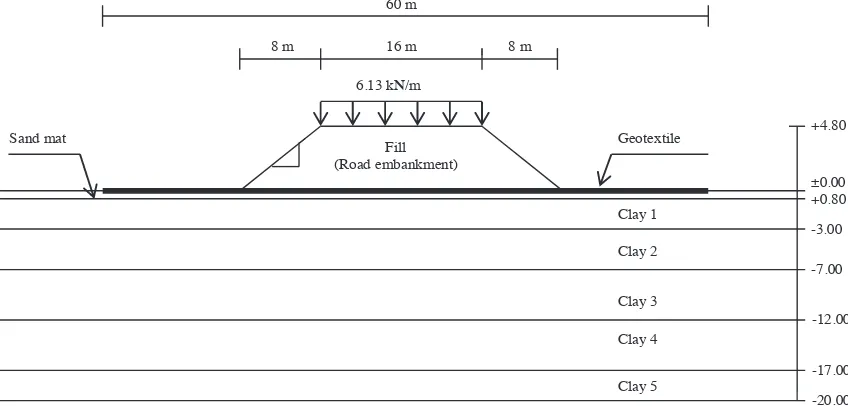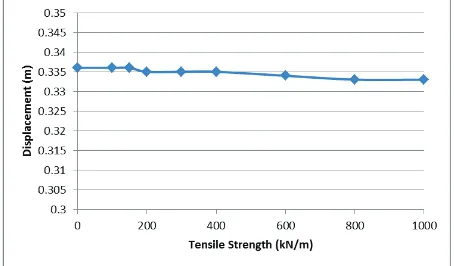Procedia Engineering 125 ( 2015 ) 358 – 362
1877-7058 © 2015 The Authors. Published by Elsevier Ltd. This is an open access article under the CC BY-NC-ND license (http://creativecommons.org/licenses/by-nc-nd/4.0/).
Peer-review under responsibility of organizing committee of The 5th International Conference of Euro Asia Civil Engineering Forum (EACEF-5)
doi: 10.1016/j.proeng.2015.11.075
ScienceDirect
The 5th International Conference of Euro Asia Civil Engineering Forum (EACEF-5)
Analysis of geotextile reinforced road embankment
using PLAXIS 2D
Paravita Sri Wulandari
a,*, Daniel Tjandra
aaPetra Christian University, Siwalankerto 121
– 131, Surabaya 60236, Indonesia
Abstract
Geotextiles have been increasingly applied as reinforcement in road embankments on soft soil. The purpose of this study is to determine the optimum tensile strength of geotextile as the reinforcement in road embankment considering the allowable factor of safety and displacement. The stability analysis of the road embankment has been done by finite element method using PLAXIS 2D. In this study, three types of sequence modeling were conducted. First, the stability of road embankment without any reinforcement was analyzed. Second modeling was to determine the length of geotextile reinforcement considering the stability of the model road embankment. The last sequence was to investigate the stability of the model reinforced embankment with various tensile strength of geotextiles reinforcement. The result of this study showed that the optimum tensile strength of geotextiles was strongly influenced by the factor of safety.
© 2015 The Authors. Published by Elsevier Ltd.
Peer-review under responsibility of organizing committee of The 5th International Conference of Euro Asia Civil Engineering Forum (EACEF-5).
Keywords: road embankment; geotextile; tensile strength; PLAXIS 2D
1.Introduction
In the recent years, as the increasing of the volume of road traffic in Indonesia, many road embankments are constructed on soft soil. In this situation, geotechnical engineers are faced with a common problem such as large settlements and slope instability. Several studies showed the using of geosynthetics as reinforcement in embankment on soft soil [1, 2, 3]. Geotextiles have been increasingly applied as reinforcement in road embankments on soft soil.
* Corresponding author. Tel.: +6-231-298-3398; fax: +6-231-298-3392.
E-mail address: [email protected]
© 2015 The Authors. Published by Elsevier Ltd. This is an open access article under the CC BY-NC-ND license (http://creativecommons.org/licenses/by-nc-nd/4.0/).
According to ASTM D4439, geotextile is a permeable geosynthetic comprised solely of textiles [4]. The geotextile reinforced embankment design should have an appropriate factor of safety and displacement. There are some researches on the application of geotextile reinforcement on soft soil. Kasim et al. determined the safe height of embankment constructed on soft ground through application of various geotextile spacing as soil reinforcement [5]. Siavoshnia et al. investigated the effect of number of geotextile layers, geotextile stiffness, and the effective length of geotextile [6]. Vashi et al. studied about the horizontal and vertical stresses and horizontal and shear displacements working on the embankment face with geotextile reinforcement at the backfill [7]. The purpose of this study is to determine the optimum tensile strength of geotextile as the reinforcement in road embankment considering the allowable factor of safety and displacement. The stability analysis of the road embankment has been done by finite element method using PLAXIS version 8.2.
2.Geometry Model
The 4 m of embankments with slopes as 2H : 1V as presented in Fig 1. was investigated in this study. The water level was at 0.00 level. A nominal surcharge of 6.13 kN/m’ has been used for modeling the traffic load. A layer of geotextile PET woven is placed between the base of embankment and the sand mat. The tensile strength of geotextile reinforcement was varied from 100 up to 1000 kN/m.
Fig. 1. Geometry model
3.Method of Analysis
In order to determine the optimum tensile strength of geotextile as a reinforcement of embankments, the tensile strength of geotextile reinforcement is varied from 100 up to 1000 kN/m. The stability analysis of the road embankment has been done by finite element method using PLAXIS 2D. The Mohr-Coulomb model was used as a simple first analysis of the problem considered. The analysis for the embankment and sand mat were modelled as drained condition while for all the foundation clay soil was modelled as undrained condition. In this study, three types of sequence modeling were conducted. First, the stability of road embankment without any reinforcement was analyzed. Second modeling was to determine the length of geotextile reinforcement considering the stability of the model road embankment. The last sequence was to investigate the stability of the model reinforced embankment with various tensile strength of geotextiles reinforcement.
4.Result and Discussion
Design of geotextile reinforced embankment is performed by determining the factor of safety with sequentially modified reinforcement until the target factor of safety is achieved. Generally, a value of 1.5 for the factor of safety with respect to strength is acceptable for the design of a stable slope. For unreinforced embankment, the safety of factor was 1.308 and the failure pattern is shown in Fig. 2. While Fig. 3. is the failure pattern for geotextile reinforced embankment using 60 m length of geotextile and 600 kN/m of tensile strength. The result of geotextile reinforced embankment analysis using PLAXIS 2D by considering the factor of safety and displacement along the base of embankment is summarized in Table 2.
Factor of safety tends to increase with increases in tensile strength of geotextile reinforcement. In Fig. 4, it is shown that by increasing the tensile strength of geotextile, the factor of safety increased until the optimum value and then decreased. It means that it is necessary to determine the optimum tensile strength of geotextile. In this study, the optimum tensile strength of geotextile reinforcement is 600 kN/m by considering the factor of safety.
The displacement was analysed along the base of embankment in order to determine the optimum tensile strength of geotextile. Increasing the tensile strength of geotextiles decreased the displacement along the base of embankment, as shown in Fig. 5. Since the displacement do not have the significantly effect by increasing the tensile strength of geotextile, this parameter could be neglected in determining the optimum tensile strength of geotextile in this study.
Fig. 3. Failure pattern of embankment with geotextile length of 60 m
Table 2. Factor of Safety and Displacement
Tensile Strength (kN/m) Factor of Safety Displacement (m)
0 1.3080 0.336
100 1.5996 0.336
150 1.6201 0.336
200 1.6355 0.335
300
1.6764 0.335
400
1.6848 0.335
600
1.7048 0.334
800
1.6136 0.333
1000
1.6142 0.333
Fig. 5. Displacement analysis
5.Conclusion
In this study, factor of safety tends to increase with increases in tensile strength of geotextile reinforcement. Since the displacement do not have the significantly effect by increasing the tensile strength of geotextile, this parameter could be neglected in determining the optimum tensile strength of geotextile in this study. Thus, it can be concluded that the optimum tensile strength of geotextile reinforced embankment in this study was strongly influenced by the factor of safety.
References
[1] D. T. Bergado, C. Teerawattanasuk, 2D and 3D numerical simulations of reinforced embankments on soft ground, Geotextiles and
Geomembranes 26 (2008) 39–55.
[2] D. Aprialdi, S. Lambert, O. Jenck,Erizal,M. Widyarti. An Original Testing Apparatus for Rapid Pull-Out Test, Civil Engineering Dimension Vol 16 No 2 (2014) 61–67.
[3] P. S. Wulandari, D.Tjandra, Determination of optimum tensile strength of geogrid reinforced embankment, International Civil Engineering Conference "Towards Sustainable Civil Engineering Practice", Surabaya (2006) 187-193.
[4] ASTM D4439-00, Standard terminology for geosynthetics, ASTM International, PA, 2000.
[5] F. Kasim, A. Marto, B. A. Othman, I. Bakar, M. F. Othman, Simulation of safe height embankment on soft ground using Plaxis, APCBEE Proceedia 5 (2013) 152–156.
[6] M. Siaovashnia, F. Kalantari, A. Shakiba, Assessment of geotextile reinforced embankment on soft clay soil, The 1st International Applied
Geological Congress, Iran (2010) 1779–1784.



